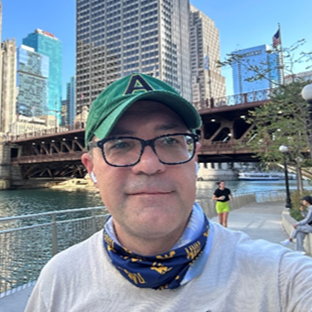Meet SfN’s Chapters Subcommittee Chair: Sergiy Yakovenko

Sergiy Yakovenko received a BS in Biophysics from the School of Radiophysics at Kharkiv National University in Ukraine. He completed his PhD in Neuroscience at the University of Alberta in Canada under the mentorship of Arthur Prochazka, studying neurophysiology and developing neuromechanical models. In his postdoctoral work with Trevor Drew at the University of Montreal, he studied descending motor pathways involved in locomotion, posture, and reaching.
He was a fellow in the Wissenschaftskolleg zu Berlin where he collaborated with Harald Wolf on the dynamics of neural pattern generation. He has also worked as a visiting scholar with Douglas Weber at the University of Pittsburgh, describing motor unit recruitment order during locomotion. In his laboratory at West Virginia University, his team studies the neuromechanical principles of motor control using experimental and computational approaches. Outside the lab, he enjoys running, chess, and tinkering with code.
What drew you to volunteer for the Chapters Subcommittee of the GMC?
As a proud member of the Society for Neuroscience and our vibrant local chapter in West Virginia, I believe in the mission of promoting neuroscience research to the public. Our chapters are vital grassroots organizations that play a crucial role in promoting the mission of the SfN, reaching millions of people worldwide. Together, we are making a significant impact on the field of neuroscience and inspiring curiosity and understanding in communities everywhere!
What value do you find in participating in local chapters?
The active participation of our chapters in educational initiatives at both school and university levels not only enriches the community but also opens exciting new opportunities in science and industry. When our dedicated members in Morgantown, a town deeply intertwined with West Virginia University, engage in Brain Awareness Week activities in schools, the enthusiastic feedback from the local community is immediate and electrifying!
What excites you the most about the opportunity to be chair of the Chapters Subcommittee?
The chapters are global ambassadors, uniting the deeply divided world. I am thrilled by the idea of promoting activities worldwide that enhance our understanding of brain functions, health implications, research, and even the commercial opportunities that arise from lab bench discoveries and progress to innovative devices. Together, we are making a global impact and fostering a deeper appreciation for the benefits that neuroscience knowledge brings!
Do you have any advice for chapter leaders looking to bolster their membership?
Building a solid group of local chapter members can begin by leveraging the resources available for Brain Awareness Week to engage both scientists and the broader community. Connecting with the local neuroscience research community is critical — this could include hosting networking events or inviting researchers to present their work in an accessible way.
Another practical idea is to organize a public movie screening featuring a film with neuroscience-related themes, accompanied by a foreword from an expert who highlights the implications of scientific ideas in the movie. This type of event can spark curiosity, foster dialogue, and showcase the relevance of neuroscience in everyday life.
Is there any additional information you’d like to share with our Chapter organizations?
Chapters can play a crucial role in advocating for neuroscience by engaging with local schools, policymakers, and the public to raise awareness about the value of neuroscience. I will look for opportunities to add resources and awards to the chapters, recognizing their successes and promoting our joint mission.





















